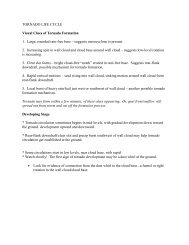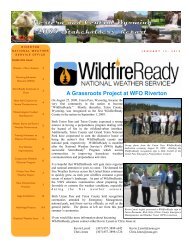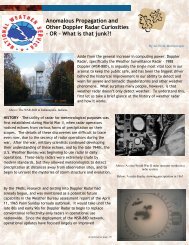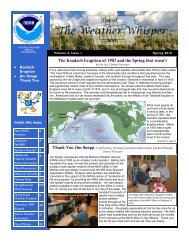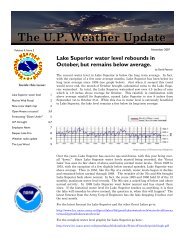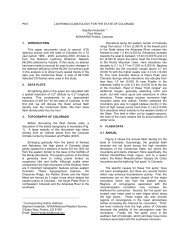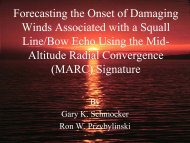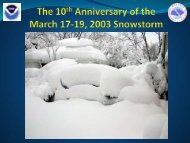Rainfall Totals from the Hermosa Flash Flood of 17 August 2007
Rainfall Totals from the Hermosa Flash Flood of 17 August 2007
Rainfall Totals from the Hermosa Flash Flood of 17 August 2007
Create successful ePaper yourself
Turn your PDF publications into a flip-book with our unique Google optimized e-Paper software.
Central Region Technical Attachment<br />
Number 08-03<br />
December 2008<br />
<strong>Rainfall</strong> <strong>Totals</strong> <strong>from</strong> <strong>the</strong> <strong>Hermosa</strong> <strong>Flash</strong> <strong>Flood</strong> <strong>of</strong> <strong>17</strong> <strong>August</strong> <strong>2007</strong><br />
Meagan Holm<br />
Melissa Smith<br />
National Wea<strong>the</strong>r Service<br />
Rapid City, South Dakota<br />
ABSTRACT<br />
During <strong>the</strong> evening <strong>of</strong> <strong>17</strong> <strong>August</strong> <strong>2007</strong>, heavy rain over north-central Custer County produced a<br />
flash flood in <strong>Hermosa</strong>, South Dakota. At 0000 UTC on <strong>the</strong> 18th, an intense thunderstorm<br />
developed along <strong>the</strong> eastern foothills <strong>of</strong> <strong>the</strong> Black Hills in central Custer County and remained<br />
stationary for at least 2 hours. Sou<strong>the</strong>asterly low-level winds fed moist air into <strong>the</strong> storms<br />
causing heavy rain to fall in and around <strong>Hermosa</strong>. By 0300 UTC, approximately 20 mi 2 had<br />
received over 6 inches <strong>of</strong> rainfall, and over 10 inches <strong>of</strong> rain fell in a 1 mi 2 just west <strong>of</strong> <strong>Hermosa</strong>.<br />
The large amount <strong>of</strong> precipitation <strong>from</strong> this storm in such a short period <strong>of</strong> time caused flash<br />
flooding across north-central Custer County. According to <strong>the</strong> Rapid City Journal, <strong>the</strong> storm<br />
damaged 60 to 70 homes around <strong>the</strong> <strong>Hermosa</strong> area. At least a half-mile section <strong>of</strong> railroad tracks<br />
and <strong>the</strong> embankment, as well as several roads and vehicles, were damaged. This paper details<br />
<strong>the</strong> meteorological conditions present for this event as well as <strong>the</strong> rainfall totals ga<strong>the</strong>red after <strong>the</strong><br />
event.<br />
1. Introduction<br />
On <strong>17</strong> <strong>August</strong> <strong>2007</strong> an area <strong>of</strong> severe thunderstorms developed over southwestern South<br />
Dakota. There were several storms which produced very large hail on this day; <strong>the</strong> two most<br />
notable were a storm that developed around Piedmont, South Dakota, and a series <strong>of</strong> storms that<br />
developed around <strong>Hermosa</strong>, South Dakota. Only <strong>the</strong> <strong>Hermosa</strong> storms will be discussed here due<br />
to <strong>the</strong> flash flooding that occurred that evening. The purpose <strong>of</strong> this paper is to document <strong>the</strong><br />
meteorological conditions, rainfall amounts, and National Wea<strong>the</strong>r Service (NWS) products<br />
disseminated throughout <strong>the</strong> course <strong>of</strong> this flash flood event.<br />
2. Meteorological Conditions<br />
2.1 Upper-Level Analysis<br />
Corresponding author’s address:<br />
National Wea<strong>the</strong>r Service Forecast Office<br />
300 E Signal Dr<br />
Rapid City SD 57701<br />
(605)341-9271; Meagan.Holm@noaa.gov, Melissa.Smith@noaa.gov
A look at <strong>the</strong> 300-mb chart <strong>from</strong> 1200 UTC <strong>17</strong> <strong>August</strong> (Fig. 1) indicates westnorthwesterly<br />
flow al<strong>of</strong>t with a weak upper-level ridge over eastern Montana and eastern<br />
Wyoming. By 0000 UTC 18 <strong>August</strong> (Fig. 2) a shortwave trough moving through <strong>the</strong> flow had<br />
flattened <strong>the</strong> ridge causing <strong>the</strong> flow at 300 mb to turn more westerly. This shortwave helped in<br />
<strong>the</strong> initiation <strong>of</strong> convection that evening and can be seen in all <strong>of</strong> <strong>the</strong> analyses to follow. A<br />
similar picture is seen at 500 mb with <strong>the</strong> flow turning <strong>from</strong> westerly at 1200 UTC <strong>17</strong> <strong>August</strong><br />
(Fig. 3) to southwesterly at 0000 UTC 18 <strong>August</strong> (Fig. 4). Again, <strong>the</strong> ridge was flattened by<br />
0000 UTC as <strong>the</strong> wave moved across western South Dakota.<br />
At 700 mb a pressure ridge was present across <strong>the</strong> nor<strong>the</strong>rn Plains with <strong>the</strong> axis stretching<br />
<strong>from</strong> nor<strong>the</strong>astern Montana to eastern Kansas. At this level, strong sou<strong>the</strong>rly flow was evident<br />
with speeds <strong>of</strong> 25 to 40 knots as indicated by <strong>the</strong> Rapid City, South Dakota (KUNR) sounding<br />
observations at 1200 UTC <strong>17</strong> <strong>August</strong> (Fig. 5) and 0000 UTC 18 <strong>August</strong> (Fig. 6). Again <strong>the</strong><br />
shortwave trough was evident as it moved across eastern Wyoming and western South Dakota.<br />
At 850 mb <strong>the</strong> flow was more meridional with high pressure over <strong>the</strong> Midwest and low pressure<br />
over <strong>the</strong> nor<strong>the</strong>rn Rocky Mountains (Fig. 7). Sou<strong>the</strong>rly flow was evident across South Dakota<br />
and Nebraska (Figs. 7 and 8).<br />
The KUNR sounding at 1200 UTC <strong>17</strong> <strong>August</strong> (Fig. 9) indicates a deep layer <strong>of</strong> sou<strong>the</strong>rly<br />
flow <strong>from</strong> <strong>the</strong> surface to approximately 600 mb: an approximate depth <strong>of</strong> 300 mb. At 0000 UTC<br />
18 <strong>August</strong> (Fig. 10) <strong>the</strong> layer <strong>of</strong> sou<strong>the</strong>rly flow extended to <strong>the</strong> termination <strong>of</strong> <strong>the</strong> sounding at<br />
500 mb producing a 400-mb-deep layer. This south to sou<strong>the</strong>asterly flow allowed very moist air<br />
(dew points were in <strong>the</strong> 60s and 70s °F across Nebraska) to advect into southwestern South<br />
Dakota. This deep layer <strong>of</strong> sou<strong>the</strong>rly flow can also be seen on <strong>the</strong> velocity-azimuth display<br />
(VAD) wind pr<strong>of</strong>ile (VWP) (Fig. 11) through 12,000 feet, which is at approximately 650 mb.<br />
The precipitable water value <strong>from</strong> KUNR at 0000 UTC 18 <strong>August</strong> (Fig. 12) <strong>of</strong> 1.41<br />
inches was 189 percent <strong>of</strong> normal, and indicated that a very moist air mass had moved into<br />
western South Dakota. This observation was higher than <strong>the</strong> mean value for <strong>August</strong> by more<br />
than two standard deviations and approached <strong>the</strong> maximum values observed at Rapid City <strong>from</strong><br />
1948 to 2000 (Fig. 13).<br />
2.2 Surface Analysis<br />
At 2100 UTC <strong>17</strong> <strong>August</strong> (Fig. 14) a surface low pressure center was located over eastern<br />
Wyoming with a stationary front draped across western South Dakota and into nor<strong>the</strong>astern<br />
Nebraska. By 0000 UTC 18 <strong>August</strong> (Fig. 15) <strong>the</strong> low pressure center drifted into southwestern<br />
South Dakota and by 0300 UTC (Fig. 16) <strong>the</strong> stationary front had pushed south extending <strong>from</strong><br />
extreme southwestern South Dakota through sou<strong>the</strong>astern Kansas. Prior to convective initiation,<br />
<strong>the</strong> surface temperatures across southwestern South Dakota were well into <strong>the</strong> 90s °F (Fig. <strong>17</strong>)<br />
while north <strong>of</strong> <strong>the</strong> stationary front temperatures were only in <strong>the</strong> 60s °F. Dew points in <strong>the</strong> 60s<br />
°F extended <strong>from</strong> west-central to south-central South Dakota (Fig. 18).<br />
2.3 Discussion<br />
The combination <strong>of</strong> a deep layer (300 mb) <strong>of</strong> south to sou<strong>the</strong>asterly flow and <strong>the</strong> compact<br />
shortwave trough approaching <strong>the</strong> area provided ample moisture and lift to initiate convection on<br />
<strong>17</strong> <strong>August</strong> <strong>2007</strong>. The precipitable water value <strong>of</strong> 189 percent <strong>of</strong> normal is well above <strong>the</strong> 142<br />
2
percent average that Maddox et al. (1979) found in his summary <strong>of</strong> western flash flood events.<br />
Maddox et al. (1980) categorized flash flood events in <strong>the</strong> western United States into four<br />
categories. This event fits into <strong>the</strong> Type II category as it corresponds well with <strong>the</strong> synoptic<br />
pattern including westerly winds al<strong>of</strong>t and observed precipitable water values <strong>of</strong> around 70 to 75<br />
percent <strong>of</strong> <strong>the</strong> maximum for that time <strong>of</strong> year.<br />
Doswell et al. (1996) put toge<strong>the</strong>r a comprehensive list <strong>of</strong> ingredients to assist <strong>the</strong><br />
forecaster in flash flood situations. The analysis above is consistent with <strong>the</strong> factors <strong>the</strong>y<br />
reviewed including deep moist convection and sustained high rainfall rates which are described<br />
in <strong>the</strong> following section.<br />
3. Observations<br />
3.1 Radar Estimates<br />
At 2330 UTC <strong>17</strong> <strong>August</strong> <strong>the</strong> first storm cell developed west <strong>of</strong> <strong>Hermosa</strong> (Fig. 19). This<br />
cell had moved past <strong>Hermosa</strong> by 2350 UTC. Ano<strong>the</strong>r smaller cell developed at 2350 UTC and<br />
moved past <strong>Hermosa</strong> by 0015 UTC. At that time <strong>the</strong> main cell was beginning to develop west <strong>of</strong><br />
<strong>Hermosa</strong>. This cell developed reflectivities in excess <strong>of</strong> 70 dBZ (Fig. 20) and remained nearly<br />
stationary west <strong>of</strong> <strong>Hermosa</strong> until 0100 UTC concentrating an area <strong>of</strong> precipitation with high<br />
rainfall rates directly over <strong>the</strong> area that would soon be flooded. Exacerbating <strong>the</strong> situation, at<br />
0100 UTC <strong>the</strong> area around <strong>Hermosa</strong> began to fill with echoes (Fig. 21) and <strong>the</strong>se echoes<br />
remained over this same area until about 0245 UTC. The final wave <strong>of</strong> showers for <strong>the</strong> evening<br />
crossed <strong>Hermosa</strong> <strong>from</strong> about 0300 to 0330 UTC.<br />
Precipitation estimates generated <strong>from</strong> <strong>the</strong> KUDX radar data using a convective Z-R<br />
relationship (Z=300R 1.4 ) indicated an area <strong>of</strong> 2 inches or more <strong>of</strong> rain fell <strong>from</strong> Custer to Red<br />
Shirt to approximately 10 miles north <strong>of</strong> <strong>Hermosa</strong> (Fig. 22). An area <strong>of</strong> 36 mi 2 centered around<br />
<strong>Hermosa</strong> received 5 to 6 inches <strong>of</strong> rain according to this estimate. When looking at <strong>the</strong> radarestimated<br />
precipitation using a tropical Z-R relationship (Z=250R 1.2 ), <strong>the</strong> area that received<br />
greater than 2 inches <strong>of</strong> rain increased slightly and <strong>the</strong> maximum rainfall detected increased <strong>from</strong><br />
5 to 6 inches to 8 to 9 inches just north <strong>of</strong> <strong>Hermosa</strong> (Fig. 23). Because <strong>of</strong> <strong>the</strong> poor performance<br />
<strong>of</strong> <strong>the</strong> tropical Z-R relationship it will not be discussed fur<strong>the</strong>r in this paper.<br />
3.2 <strong>Rainfall</strong> Reports<br />
In <strong>the</strong> weeks following <strong>the</strong> flood, <strong>the</strong> United States Geological Survey (USGS)<br />
approached <strong>the</strong> NWS to ensure rainfall amounts were documented. The USGS provided <strong>the</strong><br />
NWS with a list <strong>of</strong> rainfall reports that were collected <strong>from</strong> <strong>the</strong> general public with <strong>the</strong>ir flood<br />
survey. The NWS contacted <strong>the</strong> individuals, visited most <strong>of</strong> <strong>the</strong>ir locations, and documented <strong>the</strong><br />
rainfall and rain gage data. These reports, combined with existing rainfall reports, were used to<br />
produce an isohyetal map <strong>of</strong> <strong>the</strong> storm rainfall (Fig. 24). According to <strong>the</strong> available rainfall data,<br />
a maximum storm value <strong>of</strong> 10.50 inches <strong>of</strong> rain fell five miles west-northwest <strong>of</strong> <strong>Hermosa</strong>. An<br />
area <strong>of</strong> approximately 20 mi 2 received at least 6 inches <strong>of</strong> rain, while an area <strong>of</strong> about 1 mi 2<br />
received at least 10 inches <strong>of</strong> rain.<br />
3
Table 1 is a listing <strong>of</strong> <strong>the</strong> data that were collected through <strong>the</strong> cooperative efforts <strong>of</strong> <strong>the</strong><br />
USGS, NWS, and <strong>the</strong> help <strong>of</strong> <strong>the</strong> general public. Most <strong>of</strong> <strong>the</strong> rain fell during a period <strong>from</strong> 5:30<br />
pm to 8:30 pm (MDT).<br />
3.3 Comparison <strong>of</strong> Radar Data with <strong>Rainfall</strong> Reports<br />
Comparing <strong>the</strong> isohyetal map with WSR-88D radar data, two conclusions can be made.<br />
First, <strong>the</strong> areal coverage <strong>of</strong> <strong>the</strong> WSR-88D radar-estimated precipitation was close to <strong>the</strong> isohyetal<br />
map created <strong>from</strong> observed rainfall reports. However, <strong>the</strong> major difference was in <strong>the</strong> rainfall<br />
totals as <strong>the</strong> storm total precipitation values produced by <strong>the</strong> radar using <strong>the</strong> convective Z-R<br />
relationship were grossly underestimated. Figure 25 shows <strong>the</strong> radar-estimated storm total<br />
precipitation with <strong>the</strong> isohyetal rainfall amounts as an overlay. Storm total radar precipitation<br />
estimates near <strong>Hermosa</strong> use a 1 km by 2 km grid system. The large grid size combined with an<br />
averaging algorithm over <strong>the</strong> radar bin is most likely responsible for <strong>the</strong> underestimation <strong>of</strong> <strong>the</strong><br />
rainfall.<br />
4. Comparison to O<strong>the</strong>r Heavy Rain Events<br />
Storms <strong>of</strong> this nature are not unheard <strong>of</strong> in <strong>the</strong> Black Hills area <strong>of</strong> western South Dakota.<br />
Several storms producing rainfall in excess <strong>of</strong> 6 inches have occurred in recent history including<br />
<strong>the</strong> following: 14 June 1996 where 14.6 inches <strong>of</strong> rain fell near Piedmont, South Dakota; 7<br />
<strong>August</strong> 1999 in which 7 inches <strong>of</strong> rain fell near Custer, South Dakota; and 5 May <strong>2007</strong> where<br />
more than 6 inches <strong>of</strong> rain fell over <strong>the</strong> Badlands National Park.<br />
One may draw comparisons to <strong>the</strong> 9 June 1972 flood <strong>of</strong> Rapid Creek in Rapid City, South<br />
Dakota in which almost 15 inches <strong>of</strong> rain fell northwest <strong>of</strong> town causing Canyon Lake Dam to<br />
fail and 238 people to lose <strong>the</strong>ir lives. This event had some similar features including <strong>the</strong><br />
placement <strong>of</strong> a surface low across eastern Wyoming and a stationary front draped across western<br />
South Dakota. Some <strong>of</strong> <strong>the</strong> differences between <strong>the</strong>se two events include <strong>the</strong> placement <strong>of</strong> <strong>the</strong><br />
upper-level ridge far<strong>the</strong>r east in 1972, much lighter winds al<strong>of</strong>t in 1972, an easterly orographic<br />
lift component more prominent in 1972, and, in conjunction with <strong>the</strong>se, <strong>the</strong> duration and areal<br />
extent <strong>of</strong> <strong>the</strong> heavy rainfall was much larger in 1972 with more than 6 inches <strong>of</strong> rain falling over<br />
a 300 mi 2 area versus a 20 mi 2 area in <strong>2007</strong> west <strong>of</strong> <strong>Hermosa</strong>. Much more detailed information<br />
concerning <strong>the</strong> 9 June 1972 flood can be found in Schwarz et al. (1975).<br />
5. Chronology <strong>of</strong> NWS Products<br />
Table 2 lists <strong>the</strong> products issued by <strong>the</strong> National Wea<strong>the</strong>r Service in Rapid City, South<br />
Dakota, concerning <strong>the</strong> flood potential and ongoing flood concerns for <strong>the</strong> night <strong>of</strong> <strong>17</strong> <strong>August</strong><br />
<strong>2007</strong>. Over 48 hours before <strong>the</strong> flash flood and continuing through Friday, heavy rainfall was<br />
highlighted as a possibility in <strong>the</strong> hazardous wea<strong>the</strong>r outlook. A flash flood warning was issued<br />
for central Pennington County and nor<strong>the</strong>astern Custer County 11 minutes before any reports <strong>of</strong><br />
flash flooding occurred. A flash flood statement and a local storm report were issued during <strong>the</strong><br />
event relaying reports <strong>from</strong> law enforcement. In all <strong>the</strong> statements issued by <strong>the</strong> National<br />
Wea<strong>the</strong>r Service, <strong>Hermosa</strong> was included in <strong>the</strong> list <strong>of</strong> impacted locations.<br />
4
6. Summary<br />
In summary, <strong>the</strong> following statements can be made <strong>from</strong> <strong>the</strong> analysis <strong>of</strong> <strong>the</strong>se storms.<br />
First, very moist air was present with dew points in <strong>the</strong> upper 60s and lower 70s across<br />
Nebraska. Sou<strong>the</strong>asterly low-level winds <strong>of</strong> 20 to 40 kts fed this moist air into western South<br />
Dakota where severe thunderstorms developed. The precipitable water percent <strong>of</strong> normal value<br />
was consistent with studies done by Maddox et al. (1979, 1980) indicating very moist air was<br />
present <strong>the</strong> night <strong>of</strong> <strong>17</strong> <strong>August</strong> <strong>2007</strong> with a potential for flash floods. Second, thunderstorm cells<br />
moved over <strong>the</strong> <strong>Hermosa</strong> area during a four-hour time frame, with <strong>the</strong> heaviest rain falling in<br />
about an hour. Finally, <strong>the</strong> radar rainfall estimation provided good areal coverage, however total<br />
rainfall amounts were underestimated. The underestimate <strong>of</strong> <strong>the</strong> radar precipitation seems to be<br />
largely due to <strong>the</strong> averaging algorithm used in <strong>the</strong> WSR-88D and <strong>the</strong> localized amount <strong>of</strong> heavy<br />
rain.<br />
References<br />
Doswell, C. A., H. E. Brooks and R. A. Maddox, 1996: <strong>Flash</strong> flood forecasting: an ingredientsbased<br />
methodology. Wea. Forecasting, 11, 560-581.<br />
Maddox, R. A., C. F. Chappell and L. R. Hoxit, 1979: Synoptic and meso-α scale aspects <strong>of</strong> flash<br />
flood events. Bull. Amer. Meteor. Soc., 60, 115-123.<br />
—, F. Canova and L. R. Hoxit, 1980: Meteorological characteristics <strong>of</strong> flash flood events over<br />
<strong>the</strong> western United States. Mon. Wea. Rev., 108, 1866-1877.<br />
Schwarz, R. K., L. A. Hughes, E. M. Hansen, M. S. Petersen and D. B. Kelly, 1975: The Black<br />
Hills-Rapid City flood <strong>of</strong> June 9-10, 1972: a description <strong>of</strong> <strong>the</strong> storm and flood. Geological<br />
Survey Pr<strong>of</strong>ession Paper, 877, 1-47.<br />
5
Figure 1. 300-mb analysis <strong>from</strong> 1200 UTC <strong>17</strong> <strong>August</strong> <strong>2007</strong>. Height contours at 30-dam intervals<br />
with station plot in standard notation. Red, dashed line denotes shortwave trough location.<br />
Return to Text<br />
6
Figure 2. Same as Fig. 1, except analysis <strong>from</strong> 0000 UTC 18 <strong>August</strong> <strong>2007</strong>. [Note <strong>the</strong> 0000 UTC<br />
Rapid City sounding did not reach 300 mb (Fig. 10).]<br />
Return to Text<br />
7
Figure 3. 500-mb analysis <strong>from</strong> 1200 UTC <strong>17</strong> <strong>August</strong> <strong>2007</strong>. Height contours at 20-dam intervals<br />
with station plot in standard notation.<br />
Return to Text<br />
8
Figure 4. Same as Fig. 3, except analysis <strong>from</strong> 0000 UTC 18 <strong>August</strong> <strong>2007</strong>.<br />
Return to Text<br />
9
Figure 5. 700-mb analysis <strong>from</strong> 1200 UTC <strong>17</strong> <strong>August</strong> <strong>2007</strong>. Height contours at 20-dam intervals<br />
with station plot in standard notation.<br />
Return to Text<br />
10
Figure 6. Same as Fig, 5, except analysis <strong>from</strong> 0000 UTC 18 <strong>August</strong> <strong>2007</strong>.<br />
Return to Text<br />
11
Figure 7. 850-mb analysis <strong>from</strong> 1200 UTC <strong>17</strong> <strong>August</strong> <strong>2007</strong>. Height contours at 20-dam intervals<br />
with station plot in standard notation.<br />
Return to Text<br />
12
Figure 8. Same as Fig. 7, except analysis <strong>from</strong> 0000 UTC 18 <strong>August</strong> <strong>2007</strong>.<br />
Return to Text<br />
13
Figure 9. 1200 UTC <strong>17</strong> <strong>August</strong> <strong>2007</strong> KUNR upper-air sounding. (Courtesy <strong>of</strong> University <strong>of</strong><br />
Wyoming, http://wea<strong>the</strong>r.uwyo.edu/upperair/sounding.html)<br />
Return to Text<br />
14
Figure 10. Same as Fig. 9, except for 0000 UTC 18 <strong>August</strong> <strong>2007</strong>.<br />
Return to Text<br />
15
Figure 11. KUDX VWP <strong>from</strong> 2355−0037 UTC. X axis is time and <strong>the</strong> Y axis is height in<br />
thousands <strong>of</strong> feet MSL.<br />
Return to Text<br />
16
Figure 12. Precipitable water at 0000 UTC 18 <strong>August</strong> <strong>2007</strong>. Top number is <strong>the</strong> precipitable<br />
water value (in inches) while <strong>the</strong> bottom number is <strong>the</strong> percent <strong>of</strong> normal.<br />
Return to Text<br />
<strong>17</strong>
Figure 13. Precipitable water climatology for KUNR <strong>from</strong> 1948-<strong>2007</strong>. Max and min represent<br />
<strong>the</strong> maximum and minimum observed precipitable water values, respectively; while, 25 th , 50 th ,<br />
and 75 th represent each statistical percentage <strong>of</strong> <strong>the</strong> dataset with +2SD indicating two standard<br />
deviations <strong>from</strong> <strong>the</strong> mean. The green shaded square marks <strong>the</strong> value <strong>of</strong> 1.41 inches found on <strong>the</strong><br />
0000 UTC 18 <strong>August</strong> <strong>2007</strong> KUNR sounding.<br />
Return to Text<br />
18
Figure 14. Surface analysis for 2100 UTC <strong>17</strong> <strong>August</strong> <strong>2007</strong>. Pressure contours at 2-mb intervals<br />
with station plots in standard notation.<br />
Return to Text<br />
19
Figure 15. Same as Fig. 14, except analysis <strong>from</strong> 0000 UTC 18 <strong>August</strong> <strong>2007</strong>.<br />
Return to Text<br />
20
Figure 16. Same as Fig. 14, except analysis <strong>from</strong> 0300 UTC 18 <strong>August</strong> <strong>2007</strong>.<br />
Return to Text<br />
21
Figure <strong>17</strong>. Visible satellite image valid 2115 UTC <strong>17</strong> <strong>August</strong> <strong>2007</strong>, with <strong>the</strong> orange contours<br />
representing objectively analyzed temperatures valid at 2100 UTC with an interval <strong>of</strong> 5°F.<br />
Station plots in standard notation also are included (green).<br />
Return to Text<br />
22
Figure 18. Visible satellite image valid 2115 UTC <strong>17</strong> <strong>August</strong> <strong>2007</strong>, with <strong>the</strong> yellow-dashed<br />
contours representing objectively analyzed dew points valid at 2100 UTC with an interval <strong>of</strong><br />
5°F. Station plots in standard notation also are included (green).<br />
Return to Text<br />
23
Figure 19. KUDX WSR-88D 0.5° reflectivity valid 2330 UTC <strong>17</strong> <strong>August</strong> <strong>2007</strong>. Common cities<br />
are indicated in white while county boundaries are in gray and <strong>the</strong> South Dakota−Wyoming<br />
border is in pink. <strong>Hermosa</strong> is ~25 miles southwest <strong>of</strong> <strong>the</strong> KUDX radar, <strong>the</strong> latter <strong>of</strong> which is<br />
located just north <strong>of</strong> New Underwood, South Dakota.<br />
Return to Text<br />
24
Figure 20. Same as Fig. 19, except valid 0025 UTC 18 <strong>August</strong> <strong>2007</strong>.<br />
Return to Text<br />
25
Figure 21. Same as Fig. 19, except valid 0119 UTC 18 <strong>August</strong> <strong>2007</strong>.<br />
Return to Text<br />
26
Figure 22. Same as Fig. 19, except radar-estimated precipitation in inches using a convective Z-<br />
R relationship (Z=300R 1.4 ). Note <strong>the</strong> maximum precipitation amounts <strong>of</strong> 5 to 6 inches in <strong>the</strong><br />
<strong>Hermosa</strong> area.<br />
Return to Text<br />
27
Figure 23. Same as Fig. 19, except radar-estimated precipitation using a tropical Z-R relationship<br />
(Z=250R 1.2 ).<br />
Return to Text<br />
28
Figure 24. Rain gage precipitation amounts and contours for <strong>the</strong> 12-hour period ending at 0600<br />
UTC 18 <strong>August</strong> <strong>2007</strong>. Map is zoomed to a 15 x 15 mile square centered just west <strong>of</strong> <strong>Hermosa</strong>,<br />
South Dakota. Blue lines indicate rivers and streams and <strong>the</strong> brown lines indicated state<br />
highways.<br />
Return to Text<br />
29
Figure 25. Same as Fig. 24, except rain gage precipitation contours overlaid on radar-estimated<br />
precipitation using <strong>the</strong> convective Z-R relationship. Brown squares indicate radar bin size.<br />
Return to Text<br />
30
Latitude Longitude Total<br />
<strong>Rainfall</strong><br />
Rain Gage<br />
Type<br />
43.77028 -103.39639 3.44 4” plastic<br />
43.88968 -103.32298 3.50 Not Available<br />
Remarks<br />
Could not be contacted, estimate is<br />
reasonable.<br />
43.78888 -103.29167 3.50 Electronic Davis Pro<br />
43.79166 -103.28750 3.80 4” plastic<br />
43.87370 -103.22183 4.00 Not Available Did not visit, estimate is reasonable<br />
43.83730 -103.16800 4.00 Wedge<br />
43.80690 -103.21300 4.00 4” plastic<br />
43.75000 -103.24000 4.18 4” plastic<br />
43.81435 -103.31603 5.00 Not Available<br />
43.81600 -103.23360 5.25 5” cylinder<br />
43.81562 -103.22696 5.25 Wedge<br />
43.81127 -103.28545 5.25 Not Available<br />
43.83666 -103.33055 5.33 4” plastic<br />
43.82758 -103.19905 5.40 Not Available Did not visit, estimate is reasonable<br />
43.90325 -103.23293 5.50 Wedge<br />
43.74200 -103.24083 5.50 Electronic Davis Pro<br />
43.73829 -103.24302 6.00 5” cylinder<br />
43.73994 -103.25554 6.10 Not Available<br />
43.83065 -103.22385 6.50 5” cylinder<br />
43.82852 -103.24147 6.50 Wedge<br />
Amounts measured and dumped during<br />
rain<br />
Amounts measured and dumped during<br />
rain<br />
43.84602 -103.34125 6.50 Pint Jar<br />
Amounts measured and dumped during<br />
rain<br />
43.81432 -103.25447 6.50 4” plastic<br />
Automated gage reported about <strong>the</strong> same<br />
amount<br />
43.83435 -103.23062 6.75 8” cylinder<br />
43.834<strong>17</strong> -103.22950 6.75 Electronic<br />
43.83400 -103.23000 7.00 5” cylinder<br />
43.82470 -103.30620 8.00 4” plastic<br />
43.85890 -103.26700 8.50 Not Available Did not visit, estimate is reasonable<br />
43.85258 -103.27728 10.00 4” plastic<br />
43.84118 -103.27008 10.44 4” plastic<br />
43.85<strong>17</strong>6 -103.27446 10.50 4” plastic<br />
Table 1. Total rainfall for <strong>August</strong> <strong>17</strong> at miscellaneous gaging stations around <strong>Hermosa</strong>.<br />
Return to Text<br />
31
Date Time Product Comments<br />
8/15/07<br />
Wed<br />
332<br />
AM<br />
Hazardous<br />
Wea<strong>the</strong>r<br />
Outlook<br />
There is a chance <strong>of</strong> thunderstorms Friday and Friday night.<br />
Some storms have <strong>the</strong> potential to become severe...especially<br />
Friday afternoon and evening. Large hail...damaging<br />
winds...and heavy rainfall are all possible.<br />
8/15/07<br />
Wed<br />
632<br />
AM<br />
Hazardous<br />
Wea<strong>the</strong>r<br />
Outlook<br />
There is a chance <strong>of</strong> thunderstorms Friday and Friday night.<br />
Some storms have <strong>the</strong> potential to become severe...especially<br />
Friday afternoon and evening. Large hail...damaging<br />
winds...and heavy rainfall are all possible.<br />
8/16/07<br />
Thu<br />
333<br />
AM<br />
Hazardous<br />
Wea<strong>the</strong>r<br />
Outlook<br />
There is a slight risk for severe thunderstorms Friday...mainly<br />
in <strong>the</strong> afternoon and evening hours. The main threat for severe<br />
wea<strong>the</strong>r will be across western South Dakota and nor<strong>the</strong>ast<br />
Wyoming during <strong>the</strong> afternoon hours. Then <strong>the</strong> bulk <strong>of</strong> severe<br />
wea<strong>the</strong>r will shift toward <strong>the</strong> South Dakota plains Friday<br />
evening. Large hail...damaging winds...and locally heavy<br />
rainfall are all possible.<br />
8/<strong>17</strong>/07<br />
Fri<br />
618<br />
AM<br />
Hazardous<br />
Wea<strong>the</strong>r<br />
Outlook<br />
There is a slight risk for severe thunderstorms across all <strong>of</strong><br />
nor<strong>the</strong>ast Wyoming and western South Dakota...mainly during<br />
<strong>the</strong> afternoon and evening hours...as an upper level system<br />
passes over <strong>the</strong> area. The main threat for severe wea<strong>the</strong>r will<br />
be across far western South Dakota and nor<strong>the</strong>ast Wyoming<br />
during <strong>the</strong> afternoon hours...<strong>the</strong>n shift east across <strong>the</strong> South<br />
Dakota plains during <strong>the</strong> evening. Large hail...damaging<br />
winds... And locally heavy rainfall can be expected with <strong>the</strong><br />
stronger storms.<br />
8/<strong>17</strong>/07<br />
Fri<br />
709<br />
PM<br />
<strong>Flash</strong> <strong>Flood</strong><br />
Warning<br />
The national wea<strong>the</strong>r service in rapid city has issued a<br />
* <strong>Flash</strong> <strong>Flood</strong> Warning for...<br />
Central Pennington County in west central South Dakota...<br />
Nor<strong>the</strong>astern Custer County in southwestern South Dakota...<br />
* Until 1015 pm MDT<br />
* At 703 pm MDT...Doppler radar indicated very heavy rain<br />
<strong>from</strong> a thunderstorm over <strong>the</strong> warned area. <strong>Flash</strong> flooding is<br />
expected in <strong>the</strong> area.<br />
* Locations impacted include...<br />
<strong>Hermosa</strong>...<br />
Caputa...<br />
Farmingdale...<br />
Rapid Creek east <strong>of</strong> Rapid Valley...<br />
Spring Creek...<br />
Battle Creek...<br />
Thunderstorms will continue over <strong>the</strong> area with ano<strong>the</strong>r 3<br />
inches <strong>of</strong> rain possible through 800 pm MDT.<br />
If you live along a stream or low lying area...move to higher<br />
ground immediately to save your life. Do not wait until <strong>the</strong><br />
water gets higher.Never try to walk through fast moving water.<br />
32
Date Time Product Comments<br />
8/<strong>17</strong>/07<br />
Fri<br />
722<br />
PM<br />
<strong>Flash</strong> <strong>Flood</strong><br />
Statement<br />
...A <strong>Flash</strong> <strong>Flood</strong> Warning remains in effect until 1015 pm<br />
MDT for Custer and Central Pennington Counties...<br />
At 719 pm MDT...Doppler radar continued to indicate very<br />
heavy rain over <strong>the</strong> warned area. <strong>Flash</strong> flooding will continue<br />
in <strong>the</strong> area.<br />
Law enforcement has reported Highway 40 was flooded 5<br />
miles west <strong>of</strong> <strong>Hermosa</strong>. In <strong>the</strong> city <strong>of</strong> Custer...flooding was<br />
reported <strong>from</strong> <strong>the</strong> junction <strong>of</strong> Highways 16 and 385 to two<br />
miles east <strong>of</strong> town...north to Montgomery Street...and most <strong>of</strong><br />
<strong>the</strong> south end <strong>of</strong> town. The Custer Airport has received 2.26<br />
inches <strong>of</strong> rain so far. Thunderstorms will continue over <strong>the</strong> area<br />
with up to ano<strong>the</strong>r 3 inches <strong>of</strong> rain possible through 900 pm<br />
MDT.<br />
Locations impacted include...<br />
Custer...<br />
<strong>Hermosa</strong>...<br />
Caputa...<br />
Farmingdale...<br />
Rapid Creek east <strong>of</strong> Rapid Valley...<br />
Spring Creek...<br />
Battle Creek...<br />
French creek...<br />
Custer State Park...<br />
If you live along a stream or low lying area...move to higher<br />
ground immediately to save your life. Do not wait until <strong>the</strong><br />
water gets higher.<br />
Do not cross bridges or low lying spots covered by water.<br />
Vehicles can be swept away by only a foot or two <strong>of</strong> fast<br />
8/<strong>17</strong>/07<br />
Fri<br />
805<br />
PM<br />
Local Storm<br />
Report<br />
moving water...or <strong>the</strong> road may be washed out.<br />
0720 pm <strong>Flash</strong> 5 W <strong>Hermosa</strong> 43.84N 103.29W<br />
08/<strong>17</strong>/<strong>2007</strong> <strong>Flood</strong> Custer SD Law Enforcement<br />
Highway 40 was flooded.<br />
0720 pm <strong>Flash</strong> Custer 43.77N 103.60W<br />
08/<strong>17</strong>/<strong>2007</strong> <strong>Flood</strong> Custer SD Law Enforcement<br />
<strong>Flood</strong>ing was reported across most <strong>of</strong> Custer...<strong>from</strong> <strong>the</strong><br />
junction <strong>of</strong> Highways 16 and 385 to 2 miles east <strong>of</strong><br />
town...north to Montgomery Street...and most <strong>of</strong> <strong>the</strong> south end<br />
<strong>of</strong> town.<br />
33
Date Time Product Comments<br />
8/<strong>17</strong>/07 900<br />
Fri PM<br />
8/<strong>17</strong>/07<br />
Fri<br />
8/<strong>17</strong>/07<br />
Fri<br />
8/18/07<br />
Sat<br />
923<br />
PM<br />
1010<br />
PM<br />
1050<br />
AM<br />
Public<br />
Information<br />
Statement<br />
<strong>Flash</strong> <strong>Flood</strong><br />
Statement<br />
Local Storm<br />
Report<br />
Local Storm<br />
Report<br />
...Central and Sou<strong>the</strong>rn Black Hills...<br />
Grizzly Bear Creek near Keystone 1.07<br />
Mount Rushmore 1.23<br />
Sheridan Lake / 8NE Hill City 1.29<br />
Victoria Creek Dam 1.62<br />
Battle Creek 5 se Hill City 1.77<br />
Battle Creek near Hayward 2.18<br />
Custer County Airport 3.05<br />
Near Hayward 3.06<br />
Custer State Park 11E Custer 3.44<br />
Battle Creek near <strong>Hermosa</strong> 3.91<br />
7 SW <strong>Hermosa</strong> 4.18<br />
...A <strong>Flash</strong> <strong>Flood</strong> Warning remains in effect until 1015 pm<br />
MDT for Custer and Central Pennington Counties...<br />
At 918 pm MDT...Doppler radar estimated over 5 inches <strong>of</strong><br />
rainfall has fallen over parts <strong>of</strong> <strong>the</strong> warned area. <strong>Flood</strong>ing will<br />
continue in <strong>the</strong> area.<br />
Law enforcement has reported that water is up to <strong>the</strong> bridge on<br />
Battle Creek between Highways 36 and 40 on <strong>the</strong> south end <strong>of</strong><br />
<strong>Hermosa</strong>. Debris has been reported on <strong>the</strong> road. Battle Creek<br />
level is at 14.9 feet. <strong>Flood</strong> stage is 8.0 feet. The Creek should<br />
remain above <strong>Flood</strong> Stage until early morning as run<strong>of</strong>f<br />
continues.<br />
If you live along a stream or low lying area...move to higher<br />
ground immediately to save your life. Do not wait until <strong>the</strong><br />
water gets higher.<br />
Do not cross bridges or low lying spots covered by water.<br />
Vehicles can be swept away by only a foot or two <strong>of</strong> fast<br />
moving water...or <strong>the</strong> road may be washed out.<br />
0910 pm <strong>Flash</strong> 1 S <strong>Hermosa</strong> 43.83N 103.19W<br />
08/<strong>17</strong>/<strong>2007</strong> <strong>Flood</strong> Custer SD Law Enforcement<br />
Battle Creek flowing over Highway 79. <strong>Flood</strong> crest was 14.9<br />
feet at 900 pm MDT.<br />
1000 am Heavy Rain 7 W <strong>Hermosa</strong> 43.84N 103.33W<br />
08/18/<strong>2007</strong> m5.33 inch Custer SD NWS Employee<br />
Table 2. Products issued by <strong>the</strong> National Wea<strong>the</strong>r Service <strong>17</strong> and 18 <strong>August</strong> <strong>2007</strong>.<br />
Return to Text<br />
34




